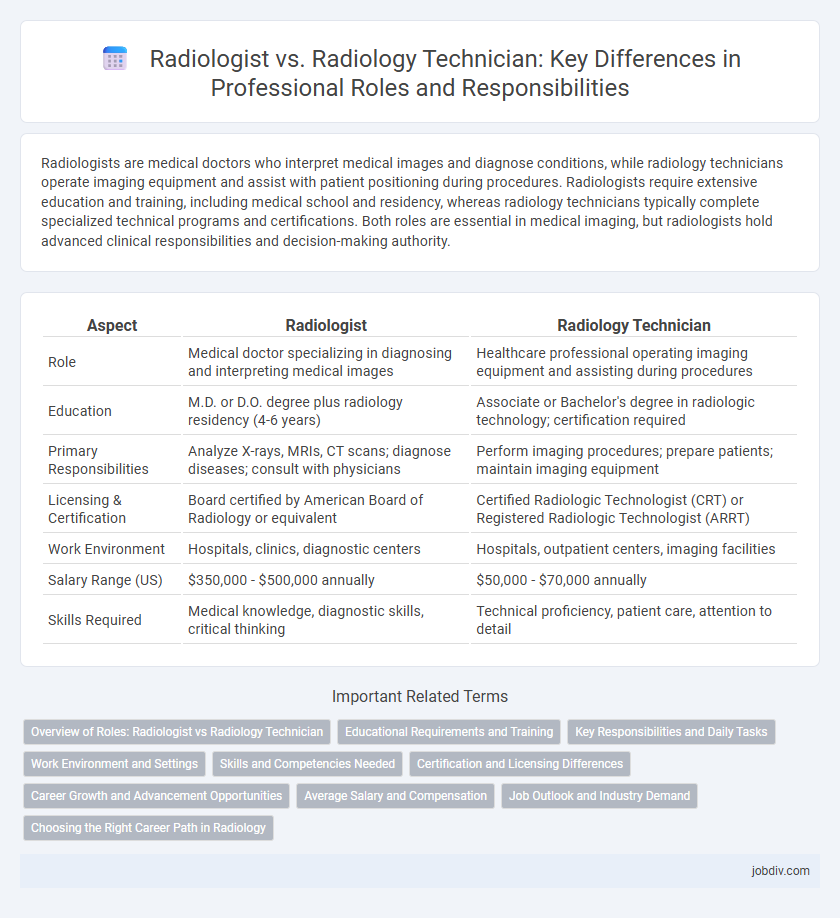Radiologists are medical doctors who interpret medical images and diagnose conditions, while radiology technicians operate imaging equipment and assist with patient positioning during procedures. Radiologists require extensive education and training, including medical school and residency, whereas radiology technicians typically complete specialized technical programs and certifications. Both roles are essential in medical imaging, but radiologists hold advanced clinical responsibilities and decision-making authority.
Table of Comparison
| Aspect | Radiologist | Radiology Technician |
|---|---|---|
| Role | Medical doctor specializing in diagnosing and interpreting medical images | Healthcare professional operating imaging equipment and assisting during procedures |
| Education | M.D. or D.O. degree plus radiology residency (4-6 years) | Associate or Bachelor's degree in radiologic technology; certification required |
| Primary Responsibilities | Analyze X-rays, MRIs, CT scans; diagnose diseases; consult with physicians | Perform imaging procedures; prepare patients; maintain imaging equipment |
| Licensing & Certification | Board certified by American Board of Radiology or equivalent | Certified Radiologic Technologist (CRT) or Registered Radiologic Technologist (ARRT) |
| Work Environment | Hospitals, clinics, diagnostic centers | Hospitals, outpatient centers, imaging facilities |
| Salary Range (US) | $350,000 - $500,000 annually | $50,000 - $70,000 annually |
| Skills Required | Medical knowledge, diagnostic skills, critical thinking | Technical proficiency, patient care, attention to detail |
Overview of Roles: Radiologist vs Radiology Technician
Radiologists are medical doctors specialized in diagnosing and interpreting medical images using advanced imaging technologies such as MRI, CT scans, and X-rays. Radiology technicians, also known as radiologic technologists, operate imaging equipment, prepare patients for procedures, and ensure the quality of captured images under the supervision of radiologists. The radiologist's role emphasizes diagnostic analysis and clinical decision-making, while the technician focuses on technical operation and patient care during imaging procedures.
Educational Requirements and Training
Radiologists must complete a medical degree followed by a residency in radiology, typically lasting 4 to 6 years, to gain expertise in interpreting medical imaging and diagnosing conditions. Radiology technicians require an associate's degree or certificate in radiologic technology, which usually takes 1 to 2 years, plus clinical training to operate imaging equipment safely and accurately. The extensive medical education for radiologists contrasts with the more technical and hands-on training of radiology technicians.
Key Responsibilities and Daily Tasks
Radiologists are medical doctors responsible for interpreting medical images such as X-rays, MRIs, and CT scans to diagnose and treat patient conditions. Radiology Technicians operate imaging equipment, prepare patients for procedures, and ensure high-quality image capture according to physician guidelines. While radiologists analyze results and formulate treatment plans, technicians focus on technical imaging accuracy and patient safety during diagnostic procedures.
Work Environment and Settings
Radiologists typically work in hospital radiology departments or specialized imaging centers, collaborating closely with physicians to interpret diagnostic images and provide accurate reports. Radiology technicians operate imaging equipment in various settings, including outpatient clinics, diagnostic laboratories, and emergency rooms, where they prepare patients and capture high-quality images. Both roles require adherence to strict safety protocols, but radiologists often spend more time in clinical consultation, whereas technicians focus on technical execution and patient positioning.
Skills and Competencies Needed
Radiologists require advanced medical knowledge in anatomy, pathology, and imaging techniques alongside proficiency in interpreting complex diagnostic images and making clinical decisions. Radiology technicians must possess technical skills to operate imaging equipment accurately, maintain patient safety protocols, and perform quality control procedures. Both roles demand strong attention to detail, familiarity with radiation safety standards, and effective communication skills for patient interaction and collaboration with healthcare teams.
Certification and Licensing Differences
Radiologists require a medical degree followed by specialized residency training and board certification from the American Board of Radiology, ensuring expertise in diagnosing and interpreting medical images. Radiology technicians must complete an accredited radiologic technologist program and obtain certification through the American Registry of Radiologic Technologists (ARRT), with state licensing requirements varying. The key distinction lies in the radiologist's advanced medical training and licensing to interpret imaging results, while technicians are certified to perform imaging procedures under supervision.
Career Growth and Advancement Opportunities
Radiologists, as medical doctors specializing in diagnostic imaging, have extensive career growth potential including subspecialization, research, teaching, and leadership roles within healthcare institutions. Radiology Technicians, while critical in operating imaging equipment, have more limited advancement opportunities often centered around gaining specialized certifications or transitioning into supervisory roles. The substantial difference in educational requirements and scope of responsibilities directly influences the breadth and pace of career advancement between these two professions.
Average Salary and Compensation
Radiologists typically earn a significantly higher average salary compared to radiology technicians, with radiologists making around $400,000 annually due to their extensive medical training and responsibilities in interpreting diagnostic imaging. Radiology technicians, who handle imaging equipment and assist in procedures, have an average salary ranging between $50,000 and $70,000 per year. Compensation packages for radiologists often include bonuses, profit sharing, and benefits that reflect their advanced expertise and clinical decision-making roles.
Job Outlook and Industry Demand
Radiologists are medical doctors specializing in diagnosing and treating diseases through medical imaging, experiencing steady demand growth driven by advances in imaging technology and an aging population requiring more diagnostic services. Radiology technicians, responsible for operating imaging equipment and assisting patients during procedures, face strong job outlooks due to expanding healthcare facilities and increasing reliance on diagnostic imaging. Both careers benefit from the healthcare industry's growth, but radiologists typically see higher demand due to their specialized expertise and critical role in patient diagnosis.
Choosing the Right Career Path in Radiology
Radiologists are medical doctors specializing in diagnosing and treating diseases using medical imaging, requiring extensive education and residency training, whereas radiology technicians operate imaging equipment and assist in patient preparation with a focus on technical skills and certification. Choosing the right career path depends on interests in patient care, academic commitment, and desired responsibilities within medical imaging. Understanding the distinction between clinical decision-making roles and technical support functions is critical for aligning career goals with professional development in radiology.
Radiologist vs Radiology Technician Infographic

 jobdiv.com
jobdiv.com